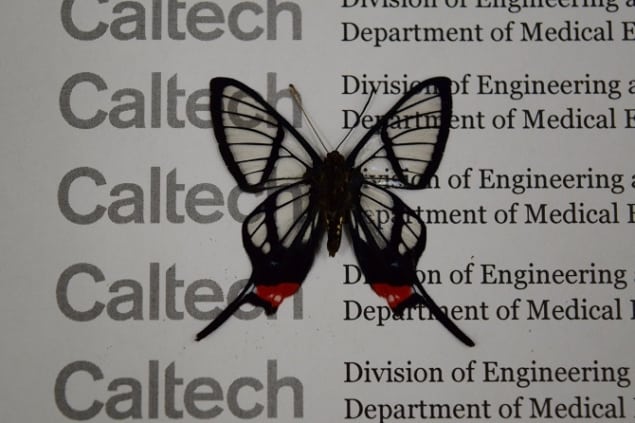
Glaucoma is the second leading cause of blindness worldwide, with numbers expected to increase every year, according to the World Health Organization. Though the cause of glaucoma remains unclear, research suggests that the disease damages eyesight via random increases in pressure inside of the eye. Medication can alleviate the pressure to prevent long-term damage, but currently, no cure for the disease exists. Developments from the Choo lab at Caltech and Sretavan lab at the University of California, San Francisco, however, could ease the lives of glaucoma patients by providing them with real-time readings of their intraocular pressure.
The team recently published the successful fabrication and testing of a new microscale implantable intraocular pressure (IOP) sensor in Nature Nanotechnology (doi:10.1038/s41565-018-0111-5). Five years in the making, the device relies on nanostructures with optical properties the team first discovered in the wings of the longtail glass butterfly species Chorinea faunus.
A flutter of inspiration
Certain sections of the wings of the butterfly are coated in nanostructures about 100 nm or 150 nm apart depending on the location on the wing. This distribution gives the wings of the species an optical property called angle-independent anti-reflection, in which their wings scatter light uniformly in all directions during transmission. The wings therefore appear transparent.
“Nature often evolves with multifunctional nanostructures for their diverse biological functions,” said co-author Radwanul Hasan Saddique, a post-doctoral fellow in the Choo lab. “The longtail glasswing was not an exception.”
The angle independency of the wings’ transparency inspired the Choo group because existing IOP sensors prior to the work reported here heavily depended on the readout angle for signal, limiting the range of detection to 10 degrees. The group therefore sought to fabricate nanostructures with the same transparency as the wings to see if they could eliminate angle dependency in IOP sensors. They found success using a silicon nitride (Si3N4) membrane, increasing the readout range to 30 degrees.
Beyond its optical properties, the membrane also prevented bio-fouling, or buildup of biological material, on the device through strong structurally mediated hydrophilicity. According to Vinayak Narasimham, a PhD student in the Choo lab, prevention of biofouling can improve the lifetime of the in vivo sensor.
Now that the team has performed initial animal studies, they are pursuing long term in vivo studies in animals. They hope to see the technology available to glaucoma patients within five years.



